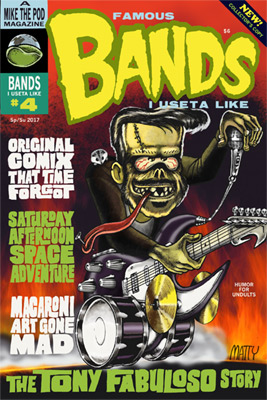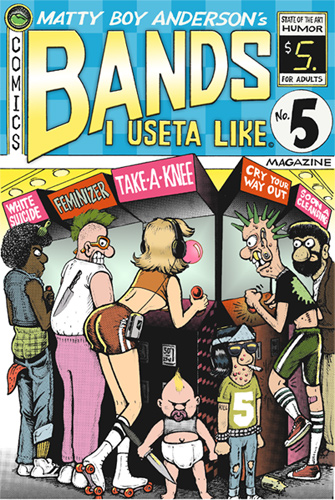3-D movies employ greatly improved technology today. Previously, they used the same glasses as 3-D comic books did; cardboard with acetate lenses in red and blue.

My personal pair, since 1991’s Freddy’s Dead: The Final Nightmare. (As much as would fit on my scanner.)
3-D comics were unreadable without these glasses. I still have two issues: Gumby 3-D and Transformers in 3-D #3, both from Blackthorne Publishing.
Because of the weird glasses required, 20th century “3-D” had its own strange atmosphere. Granted, it is sort of creepy to see an entire audience clad in identical eyewear.
The original 3-D glasses are referenced in both Gremlins (1984) and Back To The Future (1985). In the former, they’re worn very briefly by child star Corey Feldman, indoors. In the latter, they’re worn by Biff Tannen’s henchman, nicknamed, appropriately enough, “3-D”. He’s played by Casey Siemaszko, whom many will remember as the lead in 1987’s underrated Three O’Clock High.

Biff Tannen’s gang, left to right: Match (Billy Zane), Biff (Thomas F. Wilson), Skinhead (J.J. Cohen), and 3-D (Siemaszko).
Siemaszko is still a hard-working actor today, so I feel less inclined to worry about the negative effects of wearing 3-D glasses under sunlight. There’s no mention of anything on his IMDb page. But damn, every time I watch BTTF, my eyeballs ache when “3-D” walks in.
Because like him, I ignored the occasionally-printed warnings about wearing 3-D glasses under sunlight, and it cost me pretty dearly.
Over my drawing table is a color wheel. I’ve tried to keep one around since college, when I nearly flunked Color Theory without one. See, the thing is, I’m not colorblind, but I do not see colors correctly.
I can’t clearly distinguish magenta from red, or blue-green from green. It’s typically not a problem, but sometimes it makes me look like a complete fool. I can’t tell on first glance if someone has blue or green eyes, unless they’re pale blue or hazel. This is no big deal; girls don’t care if you can’t remember which eye color they have, right?
This is a result of wearing 3-D glasses outside. If I close one eye, I see a red tint; the other eye, blue. This is not a joke. Oh no.
I spend long periods of time gazing into either a white sheet of paper less than a foot beneath a 40-watt bulb, or the screen of a laptop. The key is not constantly straining your eyes. I go into tight focus only when necessary; otherwise my eyes “go slack”, using a moderate or low focus level on my entire field of vision. I wore thick spectacles in grade school (corrected to avoid a “barreled” image), and developed no depth perception whatsoever. I see everything either entirely in focus, or at a lower resolution. I can only successfully catch thrown objects if I’m wearing contact lenses, which have to correct my astigmatism.
I have no earthly idea if any of this is normal or not.
Eyeglasses used to indicate intelligence, because the only way to become intelligent was to read lots of books. This resulted in strained eyes, thanks to the poorer lighting options of the last century. I don’t like wearing glasses because I’m vain, and the prescription I require makes my eyes appear exponentially smaller. Despite this, if I’m not planning to appear in public, I’m usually wearing my glasses. Like Harvey Pekar, I’m almost never depicted with them on.
The first wave of 3-D movies had a flaw that most have forgotten: they looked affected, and imperfect. I can only imagine the complaints of headaches and such. The 3-D that we currently enjoy is beyond my understanding, and doesn’t leave after-effects. Old 3-D comics often fell prey to mothers, who’d dispose of them while cleaning, and later claim they weren’t printed properly and would’ve hurt your eyes. As comic books go, they were not user-friendly.
If you look closely at the 3-D glasses that open this article, you’ll see instructions that tell you when in the movie to put them on. That’s right- they billed Freddy’s Dead as a 3-D movie, when only a few minutes at the climax used the process. Not well, as I recall, which is probably why they didn’t hang the whole movie on it. In the times before Internet, you could get away with this kind of flim-flam.
*It didn’t.
The Elm Street series actually embraced the technology much later than its counterparts; Friday the 13th, Jaws, and Amityville Horror all made it serendipitous with their 3rd installments. (Decades later, Transformers would follow suit, with improved 3-D glasses and digital process.) The third Elm Street is my particular favorite, even though it’s in plain old 2-D.
In the 2015 of the Back To The Future series, 3-D film technology had advanced to the “no glasses required” stage. This isn’t entirely accurate… but it’s not inaccurate either.

One of the two performers pictured is a hologram. Along with Parliament’s spaceship, this remains an historic and intimidating display of hip hop technology.
There’s no way that modern movie studios would have brought 3-D back if it was still “anaglyph” (red/blue). I haven’t found anything to complain about yet in the 3-D films I’ve seen, which admittedly are few in number, and all include Transformers. I’m still kicking myself for missing that second TMNT movie in the theater, because the Technodrome scenes with Krang must’ve been spectacular. That’s a quantum leap of an improvement over Friday the 13th III, with its popcorn popping into the camera, as far as use of 3-D goes.
It wasn’t just that the technology had to be refined; the way we watch movies had to be returned to the theater, after a long absence. Concepts had to be developed that legitimately took advantage of 3-D. Ideas that needed it. Justification for twenty dollars worth of movie.
Not only that, but time had to pass, to air out the stink from the previous (red/blue) 3-D boom and bust. Pre-Internet, the label was often misapplied, or referenced jokingly.
3-D is even name-dropped in Steely Dan’s “Peg”, which I adore but many folks younger than myself detest:
Peg
It will come back to you
Then the shutter falls
You see it all in 3-D
It’s your favorite foreign movie
I guess there was a necessary break period for audiences as far as “3-D” goes. Now I’m surprised when a big-budget movie isn’t 3-D. Mad Max: Fury Road was in 3-D… and it won the Oscar for Best Picture (among others). I only support the Oscars when I agree with their choices. Otherwise, fuck ’em. I still maintain a belief that some past recipient, somewhere, stuck the head of an Oscar statue up their ass. By the law of averages, it has to have happened.

















You must be logged in to post a comment.